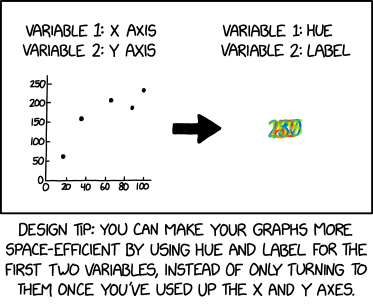Difference between revisions of "2864: Compact Graphs"
(→Transcript) |
|||
| Line 19: | Line 19: | ||
==Transcript== | ==Transcript== | ||
{{incomplete transcript|Do NOT delete this tag too soon.}} | {{incomplete transcript|Do NOT delete this tag too soon.}} | ||
| + | :[Left: graph of points plotted along two axes, headered by:] | ||
| + | :Variable 1: X Axis | ||
| + | |||
| + | :Variable 2: Y Axis | ||
| + | |||
| + | :[A arrow pointing to the right.] | ||
| + | |||
| + | :[Right: various semi-transparent numbers in different colors stacked on top of each other, headered by:] | ||
| + | |||
| + | :Variable 1: Hue | ||
| + | |||
| + | :Variable 2: Label | ||
:[Caption below the comic:] | :[Caption below the comic:] | ||
Revision as of 01:01, 7 December 2023
| Compact Graphs |
 Title text: People may complain about readability, but even with jpeg compression, extracting the data points is usually computationally feasible if there aren't too many of them. |
Explanation
| |
This explanation may be incomplete or incorrect: Created by HUGH LaBEL - Please change this comment when editing this page. Do NOT delete this tag too soon. If you can address this issue, please edit the page! Thanks. |
This comic is another one of Randall's Tips. In it, he tells graphic designers to use hue and label in their graphs to represent data from the start, rather than first using standard x and y axes and then using hue and label to represent additional dimensions (such as the z-axis). An example of hue being used to represent a dimension in a graph is on topographical maps, where the x and y axes are geographic position, and the hue (color) of a point represents the height of the terrain there. However, most people don’t know enough about hue to understand it this "graph." [citation needed]
The title text mentions that people may complain about readability, as is evident from the jumbled mess of seemingly meaningless lines in the hue and label graph in the comic. It says that discerning the data points is "computationally feasible, as long as there aren't too many of them." The decryption of information being labelled as "computationally feasible" implies that it is so difficult to discern, that the best thing that can be said about it is that it is not completely impossible.
With this particular dataset, since there are only four numbers is relatively easy to see the labels as a red 62, a green 105, a blue 230 and a yellow-orange 159, which would correspond to the pairs (9, 62),(95, 105),(215, 230) and (48, 159) respectively.
Transcript
| |
This transcript is incomplete. Please help editing it! Thanks. |
- [Left: graph of points plotted along two axes, headered by:]
- Variable 1: X Axis
- Variable 2: Y Axis
- [A arrow pointing to the right.]
- [Right: various semi-transparent numbers in different colors stacked on top of each other, headered by:]
- Variable 1: Hue
- Variable 2: Label
- [Caption below the comic:]
- Design tip: You can make your graphs more space-efficient by using hue and label for the first two variables, instead of only turning to them once you’ve used up the X and Y axes.
Discussion
Suggestion for X-axis: red - yellow - green - blue (like visible light spectral colours, but in reverse direction)
Suggestion for y-axis: 62 (red) - 159 (yellow) - 187 (blue) - 205 (green) - 230 (blue)
--172.71.246.52 21:35, 6 December 2023 (UTC)
If the second "graph" really is a representation of the same data as the first, there should be five points, corresponding to (approximately) {(17, 62), (36, 159), (67, 206), (88, 186), (100, 232)}. I copied the first plot to GIMP, cropped it, scaled it to 100x250, and measured the centres of the dots. :-) BunsenH (talk) 02:19, 7 December 2023 (UTC)
I agree with five labels. Combining these information above so far, and adding information from the Color Model HSV (also extracted with GIMP, from the large file :-)
17, 62, hue 13 (red, HEX ff3a00)
36, 159, hue 51 (yellow, HEX ffdb0f)
67, 205, hue 87 (green, HEX 8afc03)
88, 187, hue 169 (turquoise, HEX 08a387)
100, 230, hue 217 (blue, HEX 0060ff)
Does anyone find a consistent/proportional correlation between x-axis and HSV-hue? If not, it makes not much sense to mention the x-axis values in the explanation.
--LaVe (talk) 07:53, 7 December 2023 (UTC)
- Sorta! It lines up with the x values for 3 of them and the y values for 2 of them, which is unlikely to be a pure coincidence. Attempted to explain all this in my edits just now. Laser813 (talk) 20:32, 7 December 2023 (UTC)
Should we link to 2537: Painbow Award Kvarts314 (talk) 10:43, 7 December 2023 (UTC)
I think we're still missing the joke. In graph theory, there's a number of important problems and theorems related to colouring and to compact graphs (although I don't think many problems involve both concepts). Someone better versed in graph theory should chime in. 172.69.214.109 15:27, 7 December 2023 (UTC)
- I personally don't think it goes that deep, but I'm not a graph theory expert. Laser813 (talk) 20:32, 7 December 2023 (UTC)
Perhaps someone better at graphics than me could create a "key" for the Hue-Label graph, showing how the colors from 0 to 360 hue correspond to numbers? Laser813 (talk) 20:32, 7 December 2023 (UTC)
